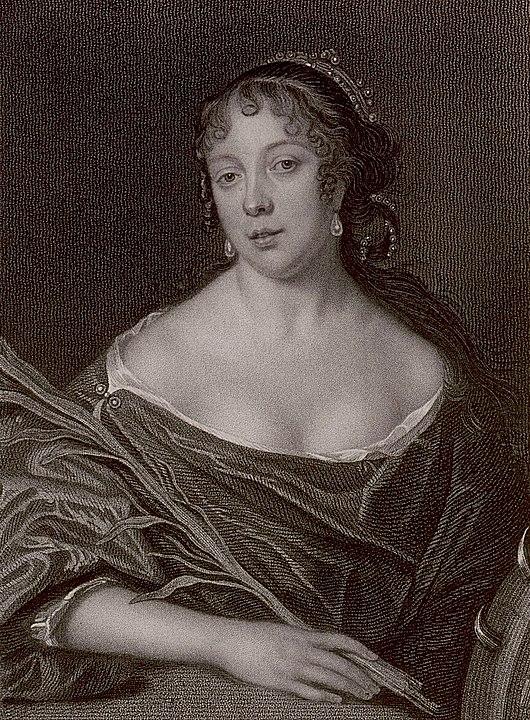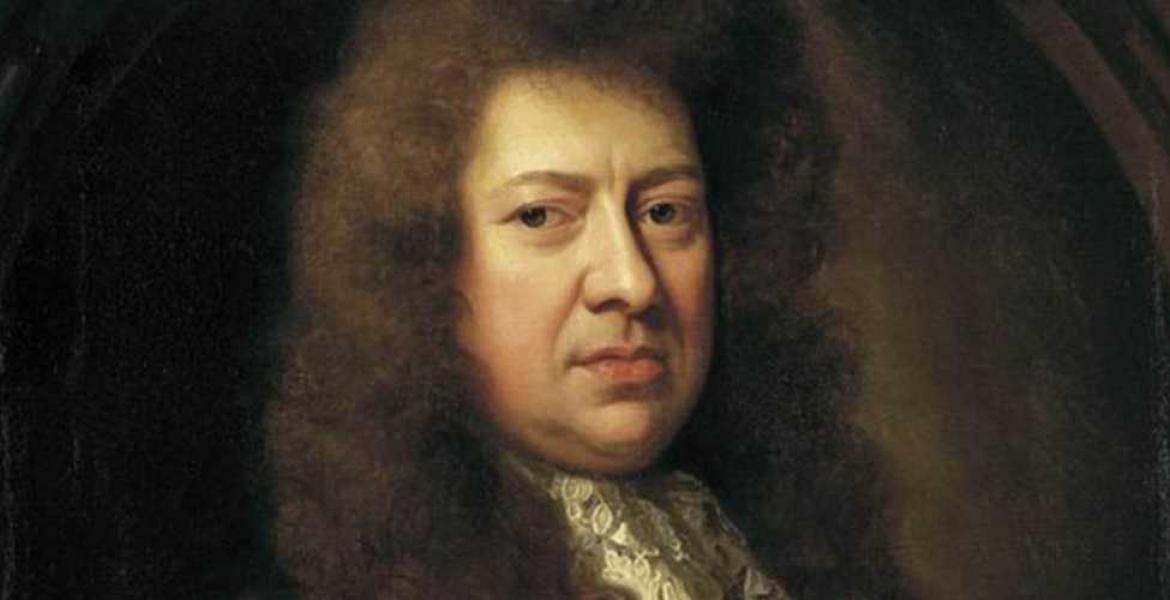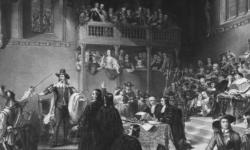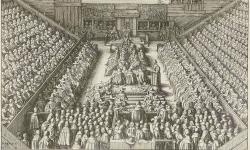Peeping Sam? The Affairs of Samuel Pepys
Key facts about Samuel Pepys
- Samuel Pepys was a politician and naval administrator, but is best known for his diary, which covered the period 1660-1669.
- The Diary has been used as an important source for many of the key events of the 1660s, including the restorationThe restoration of the monarchy and the return to a pre-civil war form of government in 1660, following the collapse of the Protectorate. of the monarchyThe king/queen and royal family of a country, or a form of government with a king/queen at the head.The king/queen and royal family of a country, or a form of government with a king/queen at the head.The king/queen and royal family of a country, or a form of government with a king/queen at the head.The king/queen and royal family of a country, or a form of government with a king/queen at the head.The king/queen and royal family of a country, or a form of government with a king/queen at the head.The king/queen and royal family of a country, or a form of government with a king/queen at the head.The king/queen and royal family of a country, or a form of government with a king/queen at the head.The king/queen and royal family of a country, or a form of government with a king/queen at the head., the plague, and the Great Fire of London.
- Unlike most contemporarySomeone or something living or occurring at the same time.Someone or something living or occurring at the same time.Someone or something living or occurring at the same time.Someone or something living or occurring at the same time.Someone or something living or occurring at the same time.Someone or something living or occurring at the same time.Someone or something living or occurring at the same time.Someone or something living or occurring at the same time. diaries, Pepys provided explicit detail about his personal life. It is therefore an invaluable resource for finding out about gender relations and marriage in the seventeenth century.
- Pepys had several extra-marital affairs over the course of the decade, some more successful than others.
People you need to know
- Mrs Bagwell - (first name unknown) wife of a ship's carpenter, and frequent lover of Samuel Pepys.
- Betty Martin - (née Lane) the subject of Pepys's regular flings, who kept a linen stall in Westminster Hall.
- Pegg Penn - 'unattractive' daughter of William Penn.
- William Penn - neighbour of Pepys, former sea captain and fellow member of the Navy Board.
- Elizabeth Pepys - (née Marchant de Saint Michel) wife of Samuel, whom she married in 1655, just before her fifteenth birthday.
- Samuel Pepys - politician, naval administrator, and diarist.
- Mary Skinner - Pepys's mistress following the death of Elizabeth, and widely accepted as his consort.
- Deborah (Deb) Willet - employed in the Pepys household (1667-8) as a companion to Elizabeth.
The Diary of Samuel Pepys is exceptional in many ways: it is considered a masterpiece of Stuart literature for its use of language, its set pieces on events such as the coronationThe ceremony of crowning a king or queen (and their consort).The ceremony of crowning a king or queen (and their consort).The ceremony of crowning a king or queen (and their consort).The ceremony of crowning a king or queen (and their consort).The ceremony of crowning a king or queen (and their consort).The ceremony of crowning a king or queen (and their consort).The ceremony of crowning a king or queen (and their consort).The ceremony of crowning a king or queen (and their consort). of Charles II and the Great Fire of London, and for the detailed self-analysis of its subject. But it is exceptional for another reason as well: it is remarkably frank when it comes to describing Pepys’s pursuit of love. The stories and incidents of his love life, both within and without marriage, are so explicit and so intimate that they weren’t published in full until the 1970s and ‘80s. Before that, they were marked as ‘objectionable’ and kept under strict lock and key. When editions of the Diary were published during the late nineteenth and early twentieth centuries, the offending passages were simply excluded.

It is hardly surprising that this was the case: between 1660 and 1669 Pepys recorded his interest in over twenty women who weren’t his wife. Almost all were below his social rank, and some were his servants or the wives and daughters of neighbours or clients. Mrs Bagwell, for example, was the wife of a ship’s carpenter who was rather cruelly exploited to help advance her husband’s career. It was ‘with many hard looks and sithes [sighs]’ that she finally allowed herself to be seduced, and thereafter she had sex with him regularly, although she once injured his hand in her effort to resist. Pepys did at least keep to his side of the bargain: he was still helping to further Mr Bagwell’s career fifteen years later. He financially helped other conquests as well: it was probably at his instigation that Betty Martin (née Lane) was awarded a pension for £100 per year under a Privy Seal warrant following the death of her husband in debtors’ prison. Claire Tomalin, Samuel Pepys: The Unequalled Self (London: Penguin, 2002), p. 330 Betty had featured regularly in the Diary and usually welcomed his advances; once, for example, Pepys recorded taking her to the Bell Inn in King Street, where ‘je l’ay foutee sous de la chaise deux times’.
Claire Tomalin, Samuel Pepys: The Unequalled Self (London: Penguin, 2002), p. 330 Betty had featured regularly in the Diary and usually welcomed his advances; once, for example, Pepys recorded taking her to the Bell Inn in King Street, where ‘je l’ay foutee sous de la chaise deux times’.  ‘I f***ed her twice under the chair’. Pepys often recorded his more private activities in a mixture of English, French, Latin, and Spanish. Yet despite her frequent appearances in the Diary, he wanted to keep his distance emotionally; he would promise to see her soon but then write of his ‘hope [that] it will be la derniere de toute ma vie’.
‘I f***ed her twice under the chair’. Pepys often recorded his more private activities in a mixture of English, French, Latin, and Spanish. Yet despite her frequent appearances in the Diary, he wanted to keep his distance emotionally; he would promise to see her soon but then write of his ‘hope [that] it will be la derniere de toute ma vie’. ‘The last time in my life’; Diary, 16 January 1664.
‘The last time in my life’; Diary, 16 January 1664.
It is, perhaps, surprising that he didn’t frequent prostitutes more, as he wanted immediate physical fulfilment more than any significant relationship. He certainly recorded instances where he flirted with the idea – in 1667 he paid a shillingOld British currency, before it went decimal. There were 20 shillings in a pound (£), and 12 pennies (d) in a shilling.Old British currency, before it went decimal. There were 20 shillings in a pound (£), and 12 pennies (d) in a shilling.Old British currency, before it went decimal. There were 20 shillings in a pound (£), and 12 pennies (d) in a shilling.Old British currency, before it went decimal. There were 20 shillings in a pound (£), and 12 pennies (d) in a shilling.Old British currency, before it went decimal. There were 20 shillings in a pound (£), and 12 pennies (d) in a shilling.Old British currency, before it went decimal. There were 20 shillings in a pound (£), and 12 pennies (d) in a shilling.Old British currency, before it went decimal. There were 20 shillings in a pound (£), and 12 pennies (d) in a shilling.Old British currency, before it went decimal. There were 20 shillings in a pound (£), and 12 pennies (d) in a shilling. to have a prostitute ‘play’ with him in a coach, and in 1664 a particularly attractive ‘wench’ caught his eye – but ‘honour and conscience’ prevented him from using them. In the latter instance, he instead took a carriage to see Betty, where he had his ‘pleasure with her twice’.  Diary, 23 July 1664 At least part of the reason is that Pepys was concerned prostitutes might not be ‘wholesome’, and particularly that he might contract the ‘pox’. It seems he believed that married women, no matter their own sexual indiscretions (or those of their husbands), would somehow be safer. The same applies to servants in his household, as they (and therefore their antics) were known, and known to be safe. In early modern England being fondled by one’s master was almost considered part of the job and Pepys was by no means the only master to sexually harass his female staff: his contemporary Robert Hooke slept with several live-in servants, including his own niece. Sometimes Pepys’s motives were darker: he seduced the unattractive Pegg, daughter of his neighbour and colleague William Penn, as a means of secretly humiliating Penn. Generally, then, sex for Pepys was perfunctory: it served a particular purpose or scratched an itch (and might in modern terms be described as an addiction), but it rarely was done with feeling.
Diary, 23 July 1664 At least part of the reason is that Pepys was concerned prostitutes might not be ‘wholesome’, and particularly that he might contract the ‘pox’. It seems he believed that married women, no matter their own sexual indiscretions (or those of their husbands), would somehow be safer. The same applies to servants in his household, as they (and therefore their antics) were known, and known to be safe. In early modern England being fondled by one’s master was almost considered part of the job and Pepys was by no means the only master to sexually harass his female staff: his contemporary Robert Hooke slept with several live-in servants, including his own niece. Sometimes Pepys’s motives were darker: he seduced the unattractive Pegg, daughter of his neighbour and colleague William Penn, as a means of secretly humiliating Penn. Generally, then, sex for Pepys was perfunctory: it served a particular purpose or scratched an itch (and might in modern terms be described as an addiction), but it rarely was done with feeling.

One of the few times this wasn’t the case was also the time that Elizabeth found out about it. Most of Pepys’s philandering was kept secret from his wife, although it is likely she had her suspicions: her frequent fits of jealousy suggest so, and she might have thought her husband’s sudden instances of generosity (such as the £4. 10s. pearl necklace he bought her following a tryst with Diana Crisp) a bit odd.  Tomalin, Samuel Pepys, p. 123. The one affair that Elizabeth did discover – because Elizabeth walked in on them – was with Elizabeth’s maid, Deborah (Deb) Willet. Deb was well-bred, innocent, and young – just out of school – when she joined the Pepys household. She provided good company for the bored and secluded Elizabeth and helped with household tasks, such as combing Samuel Pepys’s hair. Often considered an erotic act in itself, it was during one of these intimate moments that Elizabeth walked in and saw her husband ‘embracing the girl con my hand sub su coats; and indeed, I was with my main [hand] in her cunny’.
Tomalin, Samuel Pepys, p. 123. The one affair that Elizabeth did discover – because Elizabeth walked in on them – was with Elizabeth’s maid, Deborah (Deb) Willet. Deb was well-bred, innocent, and young – just out of school – when she joined the Pepys household. She provided good company for the bored and secluded Elizabeth and helped with household tasks, such as combing Samuel Pepys’s hair. Often considered an erotic act in itself, it was during one of these intimate moments that Elizabeth walked in and saw her husband ‘embracing the girl con my hand sub su coats; and indeed, I was with my main [hand] in her cunny’.  Diary, 25 October 1668. Unsurprisingly, Elizabeth was extremely angry. For weeks she railed against him, keeping him up at night calling him a ‘rogue’ and ‘dog’, and watching him like a hawk. Eventually Elizabeth extracted a full confession from Deb, who was found a position in another household, but Pepys, believing himself in love and fearing ‘it would be my ruin’, went to find her. Inevitably, Elizabeth discovered their meeting and was deeply upset. She told him she intended to leave him, demanding ‘3 or 400l of me to buy my peace, that she might be gone without making any noise’, and threatened to slit the girl’s nose. Peace was at last restored by the intervention of an old family friend, Will Hewer, and Pepys recorded his remorse in his diary:
Diary, 25 October 1668. Unsurprisingly, Elizabeth was extremely angry. For weeks she railed against him, keeping him up at night calling him a ‘rogue’ and ‘dog’, and watching him like a hawk. Eventually Elizabeth extracted a full confession from Deb, who was found a position in another household, but Pepys, believing himself in love and fearing ‘it would be my ruin’, went to find her. Inevitably, Elizabeth discovered their meeting and was deeply upset. She told him she intended to leave him, demanding ‘3 or 400l of me to buy my peace, that she might be gone without making any noise’, and threatened to slit the girl’s nose. Peace was at last restored by the intervention of an old family friend, Will Hewer, and Pepys recorded his remorse in his diary:
being most absolutely resolved, if ever I can maister this bout, never to give her occasion while I live of more trouble of this or any other kind, there being no curse in the world so great as this of the difference between myself and her; and therefore I do by the Grace of God promise never to offend her more, and did this night begin to pray to God upon my knees alone in my chamber; which God knows I cannot yet do heartily, but I hope God will give me the Grace more and more every day to fear Him, and to be true to my poor wife.
Diary, 19 November 1668
The vow didn’t last long: he saw Deb at Whitehall next spring and once again started pursuing her. She agreed to meet him, but was reasonably reluctant to allow his advances, and, by the end of the Diary, Pepys believed his relationship with her was over. There is, however, a postscript: Deb married the clergyman Jeremiah Wells in 1670, and Wells quickly became a client, and later a friend, of Pepys. Whether Pepys was simply being a generous patronA person who gives financial or other support to a client, person, organisation, or cause.A person who gives financial or other support to a client, person, organisation, or cause. and making some recompense for the situation in which he had previously placed Deb, or whether it was something more, we may never know. But it is suspicious that Pepys found Wells a position as a navy chaplain aboard the Dover, thus keeping him out of the way. Kate Loveman, 'Samuel Pepys and Deb Willet after the Diary', in The Historical Journal 49 (2006), pp. 893-901.
Kate Loveman, 'Samuel Pepys and Deb Willet after the Diary', in The Historical Journal 49 (2006), pp. 893-901.

Not all of Pepys’s pursuits were successful. With many of the women he mentioned in the Diary he got no further than a reluctant grope or two. Other times, he was fended off by the subjects of his advances. In 1667, during a church sermon, he was distracted by ‘a pretty, modest maid, whom I did labour to take by the hand and body’. She was having none of it, and slid further and further along the pew to get away from him. When this didn’t deter him, she took ‘pins out of her pocket to prick me if I should touch her again’. With this he was discouraged enough to give up, and let his attention stray to ‘another pretty maid’, who let him hold her hand for a while, before withdrawing it. ‘So the sermon ended and the church broke up, and my amours ended also.’  Diary, 18 August 1667
Diary, 18 August 1667
The Diary ended in 1669 as Pepys became concerned about his diminishing eyesight. We thus don’t know whether he ever fully reformed his character or managed to stay true to his wife. But Elizabeth did not long outlive the Diary: she contracted a fever after travelling with Pepys on the Continent, and died on 10 November 1669. Pepys never remarried, so was technically a free man, but he did develop a long-term relationship with Mary Skinner who came to be referred to as ‘Mrs Pepys’ and to whom he left money in his will. As a strong-willed woman of independent meansBeing free from outside control, particularly not depending on anyone else for money or subsistence. Being free from outside control, particularly not depending on anyone else for money or subsistence. Being free from outside control, particularly not depending on anyone else for money or subsistence. Being free from outside control, particularly not depending on anyone else for money or subsistence. Being free from outside control, particularly not depending on anyone else for money or subsistence. Being free from outside control, particularly not depending on anyone else for money or subsistence. Being free from outside control, particularly not depending on anyone else for money or subsistence. Being free from outside control, particularly not depending on anyone else for money or subsistence. , it is, perhaps, unlikely she would have allowed similar levels of infidelity, but it is the greatest loss to posterity that we will never be able to know for sure. There is much of Pepys in the Diary to dislike – his self-centredness and egotism, his failure to conquer himself and his lusts, his abuse of both his wife and the other women he mentions – but whatever our personal opinions of the man, the glimpse he gives us into the secret lives of Restoration England is priceless.
Things to think about
- What was Pepys's attitude to women?
- What insight can his diary give us into gender relationships in Restoration England?
- What roles could women play in Restoration England?
- How useful is the Diary?
- How much can the diary of one person be used to make generalisations about society?
Things to do
- Read Pepys's diary. Although the fullest edition of the Diary runs to eleven volumes and is expensive to buy, there are several anthologies on the market. https://www.pepysdiary.com/ also provides an online edition and further commentary that is very helpful.
- Have a go at transcribing his shorthand, of which there are many samples on the internet.
- Pepys was not just a diarist, but an important reformer of the navy. Visit the National Maritime Museum at Greenwich to find out more about Pepys the professional and about the history of the navy.
Further reading
For those with the time, patience, and access, nothing can beat the full Latham and Matthews' edition of the Diary, which runs to eleven volumes. For those after a more condensed version, Kate Loveman's is one of the best.
There are scores of biographies of Pepys available to buy. Some of the more readable are Claire Tomalin's Samuel Pepys: The Unequalled Self and Stephen Coote's Samuel Pepys: A Life.
For those interested in early modern gender relations, Laura Gowing's Common Bodies: Women, Touch and Power in Seventeenth Century England and Suzannah Lipscomb's The Voices of Nîmes provide an excellent introduction.The Voices of Nîmes are good places to start.
- Log in to post comments





